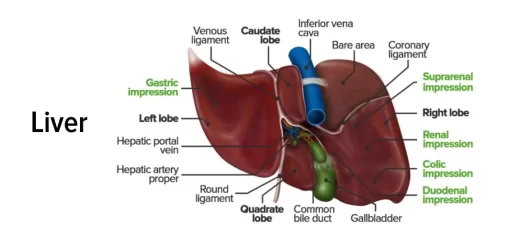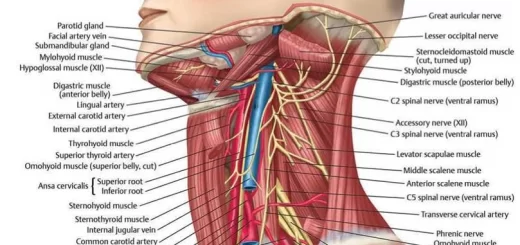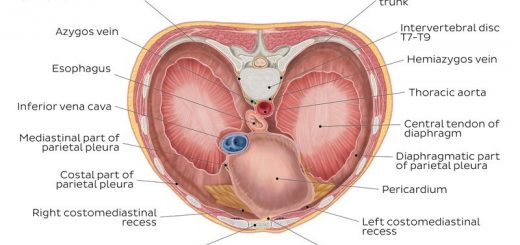Deep fascia of the foot, Extensor expansion of toes, Dorsum and Sole of the foot
The foot is the terminal portion of a limb that bears weight and it allows locomotion, It is made up of one or more segments or bones, including claws or nails. Human foot is a strong & complex mechanical structure, It contains 26 bones, 33 joints (20 of which are actively articulated), and more than a hundred muscles, tendons, and ligaments, Foot joints are the ankle and subtalar joint and the interphalangeal articulations of the foot. The foot is subdivided into the hindfoot, the midfoot, and the forefoot.
Deep fascia of the foot
1. Flexor retinaculum
This is a thickened band of deep fascia which lies on the medial side of the ankle behind and below the medial malleolus. It is attached to the medial malleolus and the medial tubercle of the calcaneus, the retinaculum is pierced by the medial calcanean vessels & nerves.
Structures deep to the flexor retinaculum:
- Tibialis posterior.
- Flexor digitorum longus.
- Posterior tibial vessels.
- The posterior tibial nerve.
- Flexor hallucis longus.
2. Plantar aponeurosis
This is a dense sheet of fibrous tissue which is attached posteriorly to medial and lateral calcanean tubercles. Anteriorly, it divides into five slips, one for each toe. it protects the underlying vessels and nerves of the sole. It is also important in maintaining the longitudinal arch.
3. Superior extensor retinaculum
The superior extensor retinaculum is a strong band of deep fascia in the lower part of the front of the leg.
Attachment: Medial: anterior border of the lower part of the tibia. while lateral attachment: triangular subcutaneous area of the fibula.
Structures deep of the superior extensor retinaculum:
- Tibialis anterior.
- Extensor hallucis longus.
- Anterior tibial vessels.
- The anterior tibial nerve.
- Extensor digitorum longus.
- Peroneus Tertius.
4. Inferior extensor retinaculum
It is a Y-shaped band that lies on the dorsum of the foot just in front of the ankle joint. The lateral end, which is the stem of the Y, is attached to the anterior part of the upper surface of the calcaneus. The upper band is attached to the anterior margin of the medial malleolus. The lower band passes medially and joints the deep plantar fascia on the medial side of the foot. The retinaculum splits to form three tunnels for passage of the extensor tendons and their synovial sheaths.
5. The superior peroneal retinaculum
It is a band of deep fascia which extends from the back of the lateral of malleolus to the lateral surface of the calcaneus. The tendon of peroneus longus and brevis pass deep to it.
6. The inferior peroneal retinaculum
Band of deep fascia which lies below lateral malleolus from stem of Y of inferior extensor retinaculum to calcaneus. It’s subdivided into 2 compartments by a fibrous septum which extends from its deep surface to be attached to peroneal trochlea on the lateral surface of the calcaneus.
Extensor expansion of toes
The tendons of the extensor digitorum longus of lateral 4 toes expand on the dorsum of the proximal phalanx and divide into three slips; Central slip is inserted into the base of the middle phalanx and two collateral slips are inserted into the terminal phalanx.
The extensor expansion is joined by the tendons of one lumbrical, two interossei muscles, and tendons of extensor digitorum brevis. The little toe has no tendon from the extensor digitorum brevis; it receives one lumbrical and only one interosseous muscle.
There is no extensor expansion for the big toe. The tendon of the extensor hallucis brevis is inserted into the base of the proximal phalanx; while that of the extensor hallucis longus is inserted into the base of the terminal phalanx. Through their attachment to the extensor expansion, the lumbrical and interossei muscles flex the metatarso-phalangeal joints and aid in the extension of the interphalangeal joints.
Dorsum of the foot
There are two intrinsic muscles only located in this compartment, the extensor digitorum brevis, and the extensor hallucis brevis, They are mainly responsible for assisting some of the extrinsic muscles in their actions, Both muscles are innervated by the deep peroneal nerve.
Extensor digitorum brevis
Extensor digitorum brevis muscle lies deep to the tendon of the extensor digitorum longus.
- Origin: from the calcaneus.
- Insertion: It attaches to the long extensor tendons of the lateral four toes.
- Actions: It helps the extensor digitorum longus in extending the medial four toes at the metatarsophalangeal and interphalangeal joints.
- Nerve supply: Deep peroneal nerve.
Extensor hallucis brevis
It is considered the medial part of the extensor digitorum brevis
- Origin: Originates from the calcaneus.
- Insertion: It attaches to the base of the proximal phalanx of the big toe.
- Actions: Aids the extensor hallucis longus in extending the big toe at the metatarsophalangeal joint.
- Nerve supply: Deep peroneal nerve.
Sole of the foot
There are ten intrinsic muscles located in the sole of the foot, All the muscles are innervated either by the medial plantar nerve or the lateral plantar nerve, which are both branches of the posterior tibial nerve, The muscles of the sole of the foot are described in four layers (superficial to deep).
First layer
The first layer of muscles is the most superficial to the sole and it is located immediately underneath the plantar aponeurosis. There are three muscles in this layer, Abductor hallucis, Flexor digitorum brevis, Abductor digit minimi.
Actions:
- Abductor Hallucis: It abducts and flexes the big toe.
- Flexor Digitorum Brevis: Flexes the lateral four toes.
- Abductor Digiti Minimi: It abducts and flexes the little toe.
Nerve Supply:
- Abductor Hallucis: Medial plantar nerve.
- Flexor Digitorum Brevis: Medial plantar nerve.
- Abductor Digiti Minimi: Lateral plantar nerve.
Second layer
The second layer contains 2 muscles; flexor digitorum accesorius (quadratus plantae), and the lumbricals, and tendons of flexor digitorum longus and flexor hallucis longus.
Actions:
- Flexor digitorum accesorius: Assists flexor digitorum longus in flexing the lateral four toes.
- Lumbricals: Flexes at the metatarsophalangeal joints, while extending the interphalangeal joints.
Nerve Supply:
- Flexor digitorum accessorius: Lateral plantar nerve.
- Lumbricals: First, lumbrical by the medial plantar nerve & lateral three by the lateral plantar nerve.
Tendon of Flexor Digitorum Longus
Splits into four tendons and inserted into the terminal phalanges of the lateral four toes.
Tendon of Flexor Hallucis Longus
This tendon passes forwards and medially deep to the tendon of the flexor digitorum longus, and is inserted into the base of the terminal phalanx of the big toe.
Third layer
Contains 3 small muscles:
Actions:
- Flexor Hallucis Brevis: It flexes the proximal phalanx of the big toe at the metatarsophalangeal joint.
- Adductor Hallucis: It adducts the great toe. It assists in forming the transverse arch of the foot.
- Flexor Digiti Minimi Brevis: It flexes the proximal phalanx of the little toe.
Nerve Supply:
- Flexor Hallucis Brevis: Medial plantar nerve.
- Adductor Hallucis: Lateral plantar nerve.
- Flexor Digiti Minimi Brevis: Lateral plantar nerve.
Fourth layer
It contains plantar and dorsal interossei and 2 long tendons; tibialis posterior and peroneus longus.
Actions:
- Plantar interossei: Adduct the lateral 3 toes and flex them at the metatarsophalangeal joints.
- Dorsal Interossei: Abduct digits two to four and flex the metatarsophalangeal joints.
Nerve Supply:
- Plantar interossei: Lateral plantar nerve.
- Dorsal Interossei: Lateral plantar nerve.
Tendon of peroneus longus
Runs in a groove on the plantar surface of the cuboid bone and is inserted into the base of the first metatarsal bone and the adjoining part of the medial cuneiform bone.
Tendon of tibialis posterior
This tendon divides into a larger medial and a smaller lateral part. The medial part is inserted, by slips, mainly into the tuberosity of navicular bone and medial cuneiform bone while the lateral part is inserted by slips into all tarsal bones except the talus and to the bases of the second, third, and fourth metatarsal bones.
Structure of skeleton of the foot, Tarsals, Metatarsals and Phalanges
Leg nerves types, Injuries of nerves of the lower limb & Sciatica causes
Leg structure, muscles, nerves, bones, anatomy and function
Popliteal fossa structure, Skeleton of the leg, Shaft & Joints of tibia
Medial compartment of thigh muscles, Growth & regeneration of smooth muscle fibers
Gluteal region structure, muscles, nerves & Posterior compartment of thigh muscles
Blood vessels of lower limb, Superior & Inferior gluteal artery, Femoral and Popliteal artery



